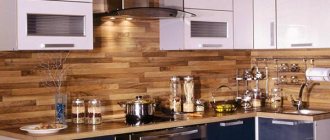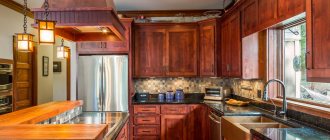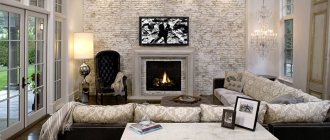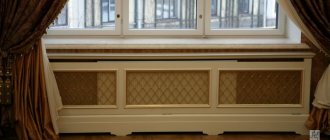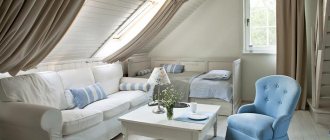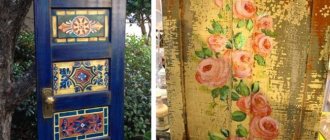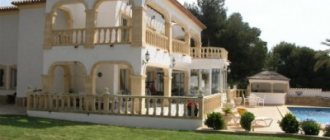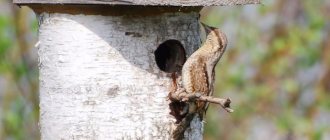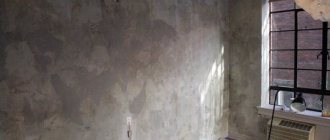Decorative moss in the interior looks incredibly stylish and literally enlivens any room. This material is used to lay out small inscriptions on walls and large-scale green compositions, decorate furniture and decorative items, and create original phyto-paintings. Live or artificial moss will fit perfectly into the interior of an apartment, country house or public space. They can decorate the walls in the living room, the cooking area in the kitchen-dining room and even the bathroom. A living moss wall will certainly evoke a feeling of peace and unity with nature.
Moss for decoration: where to get it and how much it costs
Plants are soaked in a special glycerin-based solution for 2-3 weeks. Chemical components from the tissues displace water, as a result of which the moss becomes stabilized. To prevent the decor from losing color, food coloring is added to the liquid. Preserved decoration does not need to be watered or illuminated. If you follow the rules of care, it does not lose its attractiveness for 5-7 years.
Ready-made stabilized material is offered by design and landscaping studios. Three types of decorative moss are used for decoration:
- Reindeer moss. Fluffy, beautiful coating is appropriate for creating voluminous and textured compositions. A square meter of decoration costs from $260.
- Moss in layers. The decor has a fleecy structure and looks like a lawn. Used as a basis for phytowalls. The average price is 130 euros per 1 sq. m. m.
- Stabilized by hummocks. Material with a dense texture is used to create art objects to match the natural landscape. For a square they ask to pay from 35 thousand rubles.
Fluffy moss from reindeer moss Source usgardendesignideas.blogspot.com
If you need to decorate a small area, then purchase moss in packages of 400 and 500 g. Resin moss costs from 18 to 40 dollars per pack. For a flat decor they want from 45 euros, for a fluffy tussock look - from 50 to 70. The high cost is compensated by the beauty and durability of the preserved plants.
Moss after stabilization Source growtool.ru
See also: Catalog of companies that specialize in interior redevelopment.
How to care for stabilized moss
Caring for stabilized moss is simple and anyone can easily handle it. The main thing is to initially choose a suitable place for it in the apartment.
Decorative moss does not tolerate frost or direct sunlight; it cannot be watered, sprayed or fed.
The ideal humidity for it is from forty to seventy percent. If your heating is too high in winter, you can use a humidifier.
Moss is also antistatic by nature, meaning it will not attract dust. If you notice dust on it, simply brush it off with a broom or any other soft-fiber broom.
Pictures and panels made of moss
Decor made from stabilized greenery is used to decorate the premises. A luxurious canvas with a complex structure will become a striking element in the design of the room. Works of art are available both framed and unframed. The compositions often play with the play of textures of different types of moss. The basis is plants in layers, pieces of reindeer moss and hummocks add volume. Natural materials are appropriate as a supplement:
- stones;
- bark;
- wood cuts;
- dried flowers.
Multi-colored canvases look original. For production, raw materials are used, painted in different shades. The elements are arranged in a certain sequence, forming a pattern. Designers recommend choosing one bright (accent) color, and keeping the rest in muted tones. Paintings consisting of several modules - diptychs, triptychs - look luxurious.
Canvases made from preserved moss Source www.goodly-studio.com/
Panels are used to permanently fill surfaces. The works come in both large and miniature sizes. Vertical gardening plays up the beauty of texture and color. A huge three-dimensional image on the wall of the living room and bathroom looks original. The decor in the corridor can be placed on protruding corners.
Moss wall panel Source pinterest.ru
The cost of works depends on the size and complexity of the work. A single-color painting without a frame, 30x30 cm, is valued at 3,000 rubles. For a 50x1000 cm drawing using several colors, designers ask $170. The most expensive is a panel made of decorative moss. Landscapers want 200 euros for 1 square of landscaping.
Modular painting made of moss Source pinterest.ru
If you have stabilized material, you can make a work of art yourself. You will need 100 g of raw materials per A4 sheet. Plastic or polystyrene is used as a base, onto which the contours of the design are applied. Pieces of moss are fixed using waterproof PVA glue, the remains are removed with a cloth.
Make a picture from moss yourself Source roomester.ru
About the material
When choosing suitable mosses, you need to understand their differences and placement rules. The three main groups include:
| Artificial | It is a non-living plant that is used solely for decoration. Requires careful removal of dust, since any contaminants can accumulate in its structural surface. It is usually made from plastic or derivative raw materials. |
| Alive | The plant that needs to be sprayed can be used in sunny and shaded areas. Usually reindeer moss is used to style rooms. This variety has a bright light green color. |
| Decorative | This moss is a cross between the species described above. It does not need spraying. Unlike the first type, it is created from a natural plant, and not from plastic or polymer materials. |
Lettering on the wall made of decorative moss
Stabilized plants are suitable for creating short texts. Decorative volumetric letters have a velvety surface, look original on the walls and attract people's attention. Companies use eco-logos or green signs to stand out from competitors. The cost of jewelry depends on the complexity and volume of work, on average - from $170.
Inscription made of stabilized moss Source helendecor.com.ua
At home, you can make a decorative inscription yourself. Add to blender:
- live moss – 3 handfuls;
- kefir – 1 glass;
- soaked hydrogel – 2 tbsp. spoons;
- sugar –2 tsp.
The composition is mixed for two minutes until smooth. The contours of the inscription are applied to the cleaned surface. The brush is dipped into the resulting paste and gently brushed over the text. Every 3 days the pattern is sprayed with water from a spray bottle. The lichen grows into the base, becomes established and actively develops. Landscaping grows best in the shade, so it is protected from bright sun.
Live text from moss Source vseogarage.ru
Living text from moss Source aredi.ru
Moss wall
Living moss is used in the living room interior as an accent wall. The decor covers the area from ceiling to floor in a continuous layer. Both laconic layers under the lawn and a combination of different textures are welcome. Columns and areas around the TV, decorated with stabilized vegetation, look luxurious.
Living wall in the living room Source rumossart.ru
Stabilized moss in the hall Source twitter.com
In the bedroom, a green wall is placed at the head of the bed. The decor can be combined with live ivies, ferns and dried flowers. To create a relaxed atmosphere, do not use bright combinations. The best solution for the room are shades of green.
Preserved moss on the wall in the bedroom Source pinterest.ru
The moss wall in the kitchen looks luxurious in the dining area. If the room is low, then a combination of live and painted stripes (from ceiling to floor) visually lifts the room. Stabilized greenery is used for facing the apron. The decor cannot be placed next to the stove. Canned moss looks natural on the wall in the bathroom.
Vertical gardening in the kitchen Source look-office.ru
Moss walls in the bathroom Source uudesign.ru
Myths
Myth No. 1: Moss will rot right on the wall.
Can the moss that we are offered to use in interior design actually rot? Yes, if the biological processes in it are not stopped. But stabilized moss in the interior will delight you for many years without losing its decorative effect if it was processed by professionals without violating technology. Unfortunately, more and more amateurs are appearing in this area, whose only goal is to earn more money and “dissolve in the fog,” so it is better to contact a company with a good reputation, a rich portfolio, and many satisfied clients.
Myth No. 2: moss will not take root.
Moss cannot help but take root for a simple reason: it “sleeps”. All biological processes in it are stopped. The state of stabilized moss can be considered “cryogenic freezing”. All the liquid is drawn out from the plant, and instead of it a special solution is pumped in, thanks to which the plants in the interior become unpretentious, but visually alive.
Myth No. 3: There will be midges or other insects
Moss does not attract insects. Midges do not circle over it, beetles do not appear, since all biological processes in it are stopped.
Myth #4: Moss will turn yellow or black.
What color is the moss in the interior? In most cases, customers choose lush green moss to decorate their premises - in nature it is usually gray-white. If you don’t have enough color or accent in your design, you can choose moss of any shade - it is painted with safe paints in production. It is the color of moss with which it appears on your walls that will delight you throughout the life of the plant. Properly stabilized moss cannot turn black, yellow or gray. It is important to note that it is also resistant to mold and mildew.
Myth #5: Moss will start collecting dust.
Do not worry! Your moss wall panel will not turn into a “dust collector” because stabilized decorative moss repels dust due to its density and texture. It collects no more dust than a bathroom curtain. But if you do find it, you can gently brush it off with a pipidaster.
Myth #6: Moss needs to be looked after
Do green panels in the interior need maintenance? No. Stabilized moss does not require watering, cutting, spraying or fertilizing.
Myth #7: Preserved moss is artificial moss.
Stabilized moss is the most natural moss. Just "sleeping". Thanks to special technologies, stabilized plants do not lose their elasticity, beauty, softness and shades. In a “dormant” state, they will delight you for up to 10 years.
Myth No. 8: Moss will die without light.
Moss does not require sunlight; its growth processes are stopped. It can easily be used even for decorating basements. Moss does not require any natural or artificial light sources. But if you want to emphasize the beauty of panels or other moss compositions, you can use decorative lighting.
Myth No. 9: Moss is dangerous for the health of children, allergy sufferers, and pets.
If you decide that your interior urgently needs eco-design, one of the first thoughts will most likely be this: isn’t stabilized moss dangerous? You can safely decorate your interior with it - moss is not hazardous to health, does not cause allergies, and is non-toxic. It is important that pets are usually no more interested in moss than they are in paintings on the walls.
Myth #10: Moss will dry out.
Stabilized moss does not dry out or fall off. But during the heating season and if it is close to heating devices (compositions with moss should be placed away from them), it may slightly lose its softness and elasticity. Don’t panic and don’t even try to touch or frantically water the stabilized moss - you’ll only harm it. The best thing you can do is to increase the humidity level in the room. Remember that a stabilized plant will regain its softness on its own as soon as the indoor humidity levels return to normal.
Myth #11: Moss smells bad.
Moss, of course, has its own smell, but it is not pronounced and will only be slightly noticeable in the first days of installation. Moss compositions will not cause you any problems.
Myth No. 12: if a child ruins a moss arrangement, it can be thrown away
Did the kids nibble a little on your fantasy wall or moss panel? Dont be upset. The specialists who create this green beauty can also repair it. Or give you a box of moss with repair instructions, although this is more difficult - it requires experience and dexterity.
Myth No. 13: Moss panels cannot be placed outdoors
Can. But in such a way that your fluffy wall is protected from direct rays of the sun and from rain.
Myth #14: Moss should not be placed in the bathroom.
Indoor humidity has a beneficial effect on the plant and its lifespan. This has nothing to do with spraying and watering - they are strictly contraindicated for stabilized moss.
Myth No. 15: Lighting is harmful to moss
LED lamps are the ideal solution if you decide to highlight moss. It does not heat up and does not dry out the moss compared to incandescent lamps.
Moss clock
An original accessory suitable for eco-style interiors. Externally, the decoration resembles a plant painting with a wooden baguette. A decorative element made of preserved reindeer moss with hands and a dial operates on batteries. The most common frame shapes are circle and square, although there are options like:
- hearts;
- semi-ovals;
- characters.
Watch made from preserved moss Source noktuku.com
Square clock made of moss Source edc.sale
In design studios, jewelry costs from $100. Like moss walls, you can make a living clock yourself. The mechanism with arrows is mounted to a base (made of wood or plastic). Stabilized reindeer moss is glued to the board with PVA glue, the remaining substance is removed with a dry cloth. The accessory is placed away from heating devices and directed sunlight, otherwise the plant material will darken.
Homemade moss clock Source designyoutrust.com
Features of use in design
Initially, living walls or decor were made from natural forest lichens: but this option was quickly abandoned because moss in apartments required too much care - from maintaining high humidity to constant watering and spraying. To simplify the task, the plants began to stabilize.
Stabilized moss is a natural material that has undergone a “preservation” process, allowing it to retain its original appearance and softness for a long time.
To create interior decor from living moss, natural plants of various types are collected. The standard raw material is Cladonia, a lichen widespread in forests, tropics, and deserts. After assembly, stabilization is carried out: moss is soaked in a saline solution, and dye is added if necessary.
Advantages:
- Easy to care for. A living wall or painting does not require feeding or watering.
- Aesthetics. The green composition retains its original appearance for a long time.
- Large selection of colors. Stabilized moss can be not only green, but also yellow, orange, purple, etc.
- Environmental friendliness. Although the moss is processed, it is as natural as wild plants.
Flaws:
- Demanding on the environment. Severe frost, as well as direct sunlight, negatively affect the condition of natural decoration and shorten its service life.
- Fear of water. The ingress of liquid destroys preservatives, and therefore the moss itself. This fact somewhat limits its use, but the stabilized material can be replaced with artificial moss.
- Limited service life. Even under ideal conditions, greens will only last 6-9 years, after which they will begin to dry out and crumble: the raw materials will have to be replaced with fresh ones.
Regarding the use of moss in the interior, a reservation should be made: greenery is suitable for almost all styles. But eco, loft, Scandinavian, Japandi, boho, country look especially good.
Decorative moss for the garden
In landscape design, moss is used to decorate the garden. The plant does not require care, develops quickly and recovers from unfavorable conditions. Using low-growing species, you can disguise protruding tree roots and ugly stones, or decorate a statue or bridge. The dense green covering in the recreation area looks like a velvety carpet.
Decorative moss on stone Source kitchengardenr.com
Moss decorations in the garden Source kvartira.mirtesen.ru
Moss prefers to grow in shady areas of the garden. To make the plant take root faster, it is recommended to increase the acidity of the soil with peat. In the heat, the culture stops developing, so in the evenings the surfaces are sprayed with water from a spray bottle. During the winter, it is prohibited to whitewash tree trunks on which living decorations are located.
Moss decor on stone Source yandex.uz
Decorating tiles with decorative moss Source bing.com
To decorate the landscape, designers often use moisture-loving cuckoo flax with tall stems. Flowering hybrids include white and Anders saxifrage. Externally, the crops resemble bells on thin legs that stand above the moss. For vertical gardening, low-growing dicranum, which prefers coniferous trees, is suitable. The fern variety helps to create dense openwork thickets on the site. Peat lichen has variegated shoots and loves sandy soil.
Carpet of moss under the trees Source tr.pinterest.com
Blooming species of moss Source yandex.ru
Moss rockery Source teresasplants.com
Choosing vines for vertical gardening
There are a huge number of types of vines suitable for vertical gardening, but we will tell you about the top 3 varieties that are easy to care for and give excellent results. The most famous variety is annual morning glory (it has several types). In gardens with vertical gardening, you can often see purple morning glory, the shoots of which reach 8 meters in length. In May, small decorative leaves appear on the plant, and a month later, exquisite funnel-shaped flowers appear.
Morning glory red-blue
The second well-known vine variety is kobeya. This plant came to us from Mexico. Kobeya is so loved by domestic gardeners for its incredibly beautiful flowers, reaching a diameter of 8 cm. It is better to plant the plant using the seedling method - wrap the kobeya seeds in a damp cloth, and after they hatch, transplant them into containers, covering the seeds with 2 cm of damp soil. In a couple of weeks the first shoots will appear. At the beginning of summer, transplant the plant into open ground.
The most prized variety of vines by Russian gardeners is mina (quamoclite lobed). The length of the vines reaches a length of about 3 meters, the inflorescences can reach 20 cm, surprising gardeners with their unusual two-row spicate shape. Growing such a vine is a pleasure. Wrap the seeds in a damp cloth and wait for them to germinate. After this, plant the seeds in plastic cups, while the soil should be slightly moist and loose. After 7-10 days of storage at room temperature, the seeds will grow, and at the beginning of summer the annual plant can be safely transplanted into the soil at the dacha. True, some gardeners choose containers for this.
